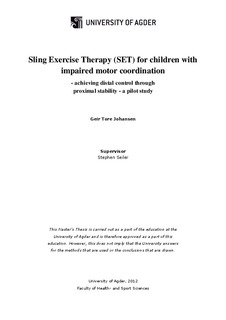| dc.contributor.author | Johansen, Geir Tore | |
| dc.date.accessioned | 2012-11-15T11:52:55Z | |
| dc.date.available | 2012-11-15T11:52:55Z | |
| dc.date.issued | 2012 | |
| dc.identifier.uri | http://hdl.handle.net/11250/138942 | |
| dc.description | Masteroppgave i idrettsvitenskap- Universitetet i Agder 2012 | no_NO |
| dc.description.abstract | Purpose: This study examined the effect of an eight week Sling Exercise Therapy (SET)
training programme in children and the response to their gross and fine motor coordination
skills. Methods: The study was a non-controlled experimental design. An intervention group
consisting of 13 boys aged 8 to 12 years identified with motor coordination difficulties trained
in an eight week long SET programme designed to strengthen their proximal stabilizing
musculature. Pre and post testing were performed using the Movement Assessment Battery
for Children (M-ABC-2) and a self developed Grapho-motor Function Test for Children
(GFTC) to quantify any changes in motor coordination and drawing skills. The GFTC
comprised three different figures of varying complexity for retracing/drawing on a digitizing
board. A specially designed computer programme calculated accuracy through to unique
variables; mean error and error standard deviation. These were combined with time to give a
score on precision. On the M-ABC-2 the 25th percentile were used as a cutoff for entry into
the project. Qualitative observations and unsolicited feedback regarding the children's
improvements were noted during the period. Results: Significant changes were observed on
the M-ABC-2 total score after the training intervention, from 64.9 on the pre test to 74.1 on
the post test (p<0.01). The effect was even stronger for the group below the 16th percentile;
from 60.4 to 72.3. All children initially identified at or below the 5th percentile had improved
out of this zone on post testing. Eight subjects improved past the 25th percentile. For the
GFTC there was a strong tendency for improvement within the group, from a precision score
of 62.8 on the pre test to 48.0 on the post test (p>0.05). For the group below the 16th
percentile on the M-ABC-2 there was a marginally significant improvement on the GFTC
from a precision score of 68.3 to 47.6 (p<0.05). Qualitative feedback included functional
improvements in everyday activities. Conclusion: Training the proximal stabilizing
musculature of children with motor coordination problems seems to yield considerable
improvements in their motor control skills. Findings suggest that this may also apply to
grapho-motor function. Due to limitations in this study further research is required to properly document these effects. | no_NO |
| dc.language.iso | eng | no_NO |
| dc.publisher | Universitetet i Agder ; University of Agder | no_NO |
| dc.subject.classification | IDR 506 | |
| dc.title | Sling exercise therapy (SET) for children with impaired motor coordination : achieving distal control through proximal stability - a pilot study | no_NO |
| dc.type | Master thesis | no_NO |
| dc.subject.nsi | VDP::Medical disciplines: 700::Health sciences: 800::Health service and health administration research: 806 | no_NO |
| dc.source.pagenumber | 47 s. | no_NO |
